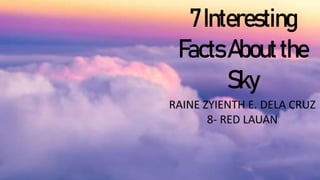
7 Interesting Facts about the Sky
- 1. 7Interesting FactsAboutthe Sky RAINE ZYIENTH E. DELA CRUZ 8- RED LAUAN
- 2. CloudsAreHeavy •Large, fluffy clouds are frequently seen in the sky, and because they are drifting around, they appear light. The opposite is true, as you can see. •The average cumulus cloud weights 1.1 million pounds, according to the United States Geological Survey! Although they may not be dense, clouds can support a lot of weight.
- 3. WhenYouLookatStars,You’reLookingatthePast •Light travels at the same pace as everything else. The light of an object travels more slowly the further out in space it is. •If you can see the Andromeda galaxy, you can see that it took 2.5 million years for light from that galaxy to reach here. Light from Sirius takes 8.6 years to reach us. In other words, you are viewing the galaxy as it was 2.5 million years ago when you look at it. •If they are looking at the Milky much, if there is life on a planet in that far-off galaxy, they will witness how things were 2.5 million years ago, much before Homo sapiens even started to evolve!
- 4. SomeVisibleStarsAre19QuadrillionMilesAway •Between 2,600 and 3,000 light-years, or around 19 quadrillion miles, separate us from the star Deneb. Deneb frequently ranks among the brightest stars in the sky with a brightness of 1.25. •Even though that is a significant distance, it is still relatively close by astronomical standards. 52,850 light-years across, the Milky Way is still within 19 quadrillion miles of us!
- 5. StarsDon’tTwinkle •You might notice a star flashing in and out of existence in the night sky. When you stare at the stars, you may notice what is known as a twinkle. Stars don't actually sparkle, despite what you're witnessing. •It has to do with how the atmosphere of Earth affects what you can see and how visible light travels through it. You won't notice any twinkling if you ever get to travel to space and observe the stars!
- 6. YouCanOnlySeeHalftheNightSkyatOnce •There are a tonne of stars visible when you look up at the night sky, but what's astonishing is that you can only see roughly half of it at once. •There is a lot of arithmetic involved in establishing this, but it all makes sense if you imagine that you are standing on a spherical. Even when we are facing that direction, the Sun is so bright that it obscures anything else that we could see, making it impossible to see through the Earth to what is on the other side.
- 7. ThereAreAround2TrillionGalaxiesintheUniverse •The size of the universe is enormous. In fact, a recent study suggests that the observable universe contains about 2 trillion galaxies. •The present number is likely lower even though the galaxies themselves are larger since many scientists believe that many of these galaxies have merged into other galaxies over time. However, even though the universe is full of galaxies, you can rarely see any of them from your backyard.
- 8. ThereAre100BillionStarsintheMilkyWay •In the observable universe, there are a tonne of galaxies, and if the Milky Way is any indication, there are a tonne of stars in each galaxy. According to the European Space Agency, the Milky Way alone contains some 100 billion stars! •But that figure is continually changing. The precise number of stars is continually fluctuating as new stars are created and old stars die. It's more of a guess as nobody counts them out individually.
- 9. References: • https://opticsmag.com/sky-facts/ • https://www.pacificflying.com/what-are-different-types-of-clouds/ • https://stock.adobe.com/ph/search?k=high+resolution+galaxy • https://www.quora.com/What-exactly-is-the-Galactic-Center-and-how-can- I-watch-it • https://www.istockphoto.com/photo/beautiful-sunset-sky-above-clouds- with-nice-dramatic-light-view-from-airplane-window-gm1045890176- 279869152 • https://www.forbes.com/sites/startswithabang/2020/09/07/are-any-stars- visible-in-the-night-sky-already-dead/?sh=65f057277809 • https://www.astronomy.com/astronomy-for-beginners/written-in-the-stars- how-humans-pick-out-constellations/ • https://stocksnap.io/search/starry
- 10. 7Interesting FactsAboutthe Sky RAINE ZYIENTH E. DELA CRUZ 8- RED LAUAN